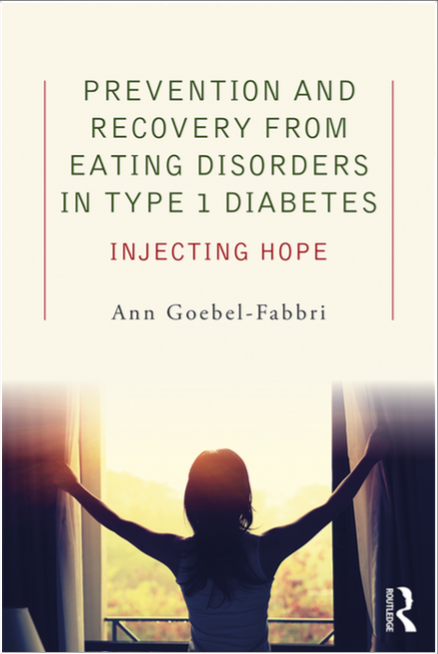Help Your Loved One with a Type 1 Diabetes Eating Disorder
 If you are a family member or a friend of someone who has type 1 diabetes and you suspect that he or she may be struggling with an eating disorder, here are seven tips to help you help them.
If you are a family member or a friend of someone who has type 1 diabetes and you suspect that he or she may be struggling with an eating disorder, here are seven tips to help you help them.
Note: The Book, Injecting Hope, sheds light on an often overlooked and misunderstood issue: the problem of eating disorders in people with type 1 diabetes – often referred to by lay people and the media as “diabulimia” and characterized by insulin restriction as a means calorie purging and weight loss. Drawing on a series of recent interviews and over 15 years of research and clinical experience with this unique phenomenon, author Dr. Ann Goebel-Fabbri provides groundbreaking insight into the lives of women who have recovered from eating disorders in type 1 diabetes. She explores the condition’s origins, its effects on the lives of those affected and possible paths to recovery. Also included are suggestions for prevention and treatment as well as practical and inspirational advice from now recovered former-patients. Injecting Hope is a valuable guide for patients and loved ones, diabetes treatment teams and eating disorder clinicians.
[Excerpted from Prevention and Recovery from Eating Disorders in Type 1 Diabetes: Injecting Hope, pp. 95-98. © 2017 by Ann Goebel-Fabbri. Reprinted with permission from Routledge.]
Tip 1: Know the warning signs of an eating disorder and the symptoms of DKA
Please review warning signs of diabetic ketoacidosis (DKA). It is important to note that not all eating disorders include insulin restriction and related elevated blood glucose ranges. They can also be characterized by extreme food restriction as in anorexia nervosa or by bingeing and purging through other means. However, the warning signs listed here are primarily associated with insulin restriction. People with type 1 diabetes mellitus (T1DM) may restrict their insulin for a number of reasons and not just because of an eating disorder. Such reasons may include fear of hypoglycemia, burn out from the burden of T1DM self-care, frustration related to perfectionism around blood glucose targets, and many other underlying causes. Because many factors may result in insulin restriction, it is important to try to understand what is leading your loved one to restrict insulin. Having an open, nonjudgmental conversation about your concerns may help you to understand your loved one’s particular cases. You can also let the diabetes team know about your concerns and request that they try to address it in order to gain a better understanding of what is triggering the insulin restriction.
Signs and symptoms of DKA
- Profound thirst and frequent urination
- Fatigue
- Nausea and/or vomiting
- Muscle pain and weakness
- Deep and labored breathing
- Chest pain
- Disorientation or confusion
- “Large” level of ketones. Ketones may be recognized by their distinctly fruity smell.
**Please note: not all symptoms need to be present to indicate medical risk.
Warning signs of eating disorders in T1DM
- Unexplained elevations in A1C values*
- Concerns about weight and body shape**
- Change in eating patterns, which may include finding evidence of dietary restriction during the day and binge eating in the evening
- Intense exercise (sometimes associated with frequent hypoglycemia)
- Repeated problems with diabetic ketoacidosis (DKA)*
- Amenorrhea (skipping monthly menstrual periods)
*Some of these warning signs are specific to eating disorders with insulin restriction.
**Please note that there is not one particular body size that should trigger concern. People can have what appears to be healthy body weight and still be experiencing medically significant eating disorder symptoms.
Tip 2: Learn about eating disorders and T1DM
When trying to support someone with an eating disorder and T1DM, it is helpful to learn about both conditions separately and also about this unique combination. Some of the women felt that their loved ones did not appreciate enough about what it means to struggle with an eating disorder in T1DM and that this led them to make suggestions or comments that did not help. For example, telling someone to “just eat” or “just take your insulin” diminishes the complexity and difficulty of having this dual diagnosis. People do not have eating disorders and restrict insulin because they don’t understand how to manage their diabetes but because they are under the control of a psychological condition. This eating disorder is not solely about food or insulin. It is about fear of insulin, fear of calories, fear of weight and a distorted sense of body size. Unfortunately, simply applying logic and what they know about diabetes is not powerful enough to successfully wage war against their eating disorder. This is an illness not a lack of understanding, denial, or simple apathy.
Tip 3: How to discuss your concerns
If you suspect that a loved one has an eating disorder, feeling worried and scared is a completely understandable response. Add T1DM to that situation and its complexity and danger are heightened. Despite your understandable feelings of concern, the women who were interviewed thought it best to approach your loved one without coming across as too alarmist but rather as calm and caring. Many of them spoke of feeling most helped by a communication style characterized by warmth combined with directness. They felt clear that a judgmental or confrontational style was more likely to cut off open communication and contribute to secrecy. The participants strongly discouraged the use of “Tough Love.”
Tip 4: What kind of support to provide
How to support your loved one will vary based on who they are and what they feel they need. Different people will want more or less involvement. Some of the women wanted more concrete help, while others wanted more emotional support. Still others preferred to maintain more independence but found it supportive just to know that loved ones would be there if needed. Rather than you deciding how best to support your loved one, it is more helpful to ask how you can be involved and what kinds of things you can do to help. The challenge will be preparing yourself for what they let you know that they need. For example, you may be asked to change the way you speak about T1DM and its management. Try not to respond to these sorts of requests defensively. Convey your love and your wish to help in any way and allow them to guide what they need from you and whether or how you become involved.
Tip 5: Do not resort to fear tactics or shaming
Watching a loved one succumb to the power of an eating disorder can understandably lead to feelings of desperation and fear. Because of this, family and friends may resort to expressing anger or trying to instill fear to motivate their loved ones into treatment. It is frustrating not to be able to help, and understandable that this frustration and worry can boil over. What the recovered women described, however, was that this approach led them to shut people out and hide their eating disorder from their loved ones. They also said that threats about diabetes complications were not helpful, because they were well aware of the risks and such lectures just made them feel scared and even more misunderstood. For these reasons, it appears to be more effective to provide consistent support and encouragement to improve T1DM self-care without threats and shame.
Tip 6: Commit to ending the “body talk”
As mentioned in Chapter 8, body dissatisfaction and weight consciousness has become a norm among women. This is one factor that can raise the risk for women to develop an eating disorder. Many of the women in this book noted that they came from families or peer groups where eating and weight was a major focus, where dieting was common, and where weight dissatisfaction was frequently discussed. Happily, this is something that can actually be quickly and successfully modified in families and friendship groups. It is relatively easy to stop discussing negative body image, various weight loss diets and commenting on others’ weight (negatively or positively). Friends and families can decide that these are no longer topics for discussion even if they continue to have these concerns about themselves.
Tip 7: Encourage flexible eating
Modern insulin regimens have eliminated the need to follow a particular “Diabetic Diet.” A person with T1DM can eat what everyone else is eating and does not require special sugar-free foods. The women spoke about the impact of making certain kinds of food off-limits and how it can lead to feelings of deprivation followed by shame and secrecy when the person with T1DM eventually eats them. These feelings may actually promote the risk of bingeing and purging with insulin restriction or other means. Flexible eating and moderate portions are what is being recommended as a healthy eating approach for everyone and not just those with T1DM. Therefore, loved ones and people with T1DM can all adopt the same style of eating where nobody needs to feel like they are being deprived of certain foods.





